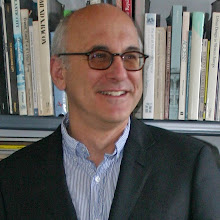 Lorraine and Denise before a meal at Lou, a slow food wine bar tucked into the corner of a mini-mall south of Hollywood, California
Lorraine and Denise before a meal at Lou, a slow food wine bar tucked into the corner of a mini-mall south of Hollywood, CaliforniaYesterday, a San Franciscan and I had a conversation. He had eight hours before his plane ride home. He challenged me, "where do you go in Los Angeles if you have time to kill?" For any Angeleno this is an existential challenge. We use the city peripatetically, rarely going just one place, instead hopping about through great swaths of space. To MOCA, SMOA, LACMA, Runyon Canyon, Griffith Park, Downtown, the beach, etc. each a delight, but not connected or sustaining interest for an entire day.
Politically Los Angeles resembles Jane Jacob's Greenwich Village, but in practice this city remains closer to Reyner Banham's four sprawling and overlapping ecologies; surfurbia, foothills, the plains of id (where most of us live) and autopia (how most of us get around). "Hey", I told my freind, "if you want to see Los Angeles, visit a mini-mall."
Reyner Banham pays scant attention to mini-malls in his book but they are the logical typological consequence of a city that lives at once on the beach, in the hills, throughout the flats of the geographic basins and valleys and in cars (and I dare say even buses and trains). Angelenos are on the move across vast distances, at least in comparison to traditional urban situations and mini-malls are the halfway houses, the outposts, the forts and campgrounds of convenience.
Every Angeleno mentally maps the Los Angeles locales where they buy a bottle of water, drop off and pick up cleaning, wash pets, grab take-out, exercise, visit chiropractors and weight control specialists, indeed take care of all daily needs. Unheralded yet essential to everyday life, this minicity of "L" shaped haunts is our secret city where we spend the hours and the days of our lives.
Perhaps least obvious to the outsider is how mini-malls, despite lacking the traditional elan of great urban places, increasingly transcend definitions of high and low culture, realizing a type of placeless place to be that is the definition of this place, Los Angeles. One can find the world in a Los Angeles mini-mall. From ethnic foods of every type to goods from every continent, storefront churches and book stores, jewelry and clothing, photo-finishing and fried chicken, art galleries and light industrial manufacturing, there are mini-malls that feature any activity one can imagine or anticipate. You just have to first define your need and then seek it out.
 Melrose Plaza, at the corner of Vine Street and Camerford Avenue in Los Angeles, features the slow food wine bar Lou, as well as a laundromat, burger stand, Guatemalan chicken restaurant and Thai massage parlor.
Melrose Plaza, at the corner of Vine Street and Camerford Avenue in Los Angeles, features the slow food wine bar Lou, as well as a laundromat, burger stand, Guatemalan chicken restaurant and Thai massage parlor.Upon reflection I would suggest that my San Francisco friend spend the hours before his flight at the mini-mall pictured above, Melrose Plaza. This is the "Lou" mini-mall at the southeast corner of Vine Street and Camerford Avenue south of Hollywood. I could wax poetic about the convenient parking, the stunning views of the hills to the north, the curious residential neighborhoods and studio haunts within a quarter mile walking distance, but the real secret here is Lou. Lou is a slow-food restaurant and wine bar. Lou is the guy who owns the place and stands behind the bar and pours the wine and picks the music. The interior is dark and the music is smoky even if one can't smoke. A curtain hides the view out and the view in. You could and I did drive by the place a dozen times before stopping in. On any given day or evening you might run into friends, neighbors, celebrities or just sit alone and talk to Lou. To the San Franciscan who doesn't want to drive in LA, take a taxi to Melrose Plaza, eat a meal, get a massage, look at the hills, enjoy a glass of fine wine and get to know Lou and get to know Los Angeles.

No comments:
Post a Comment